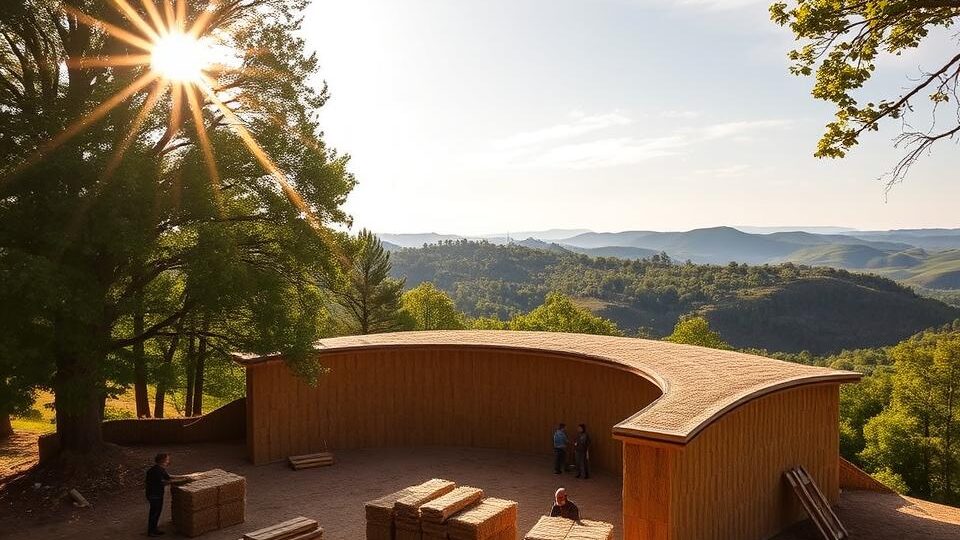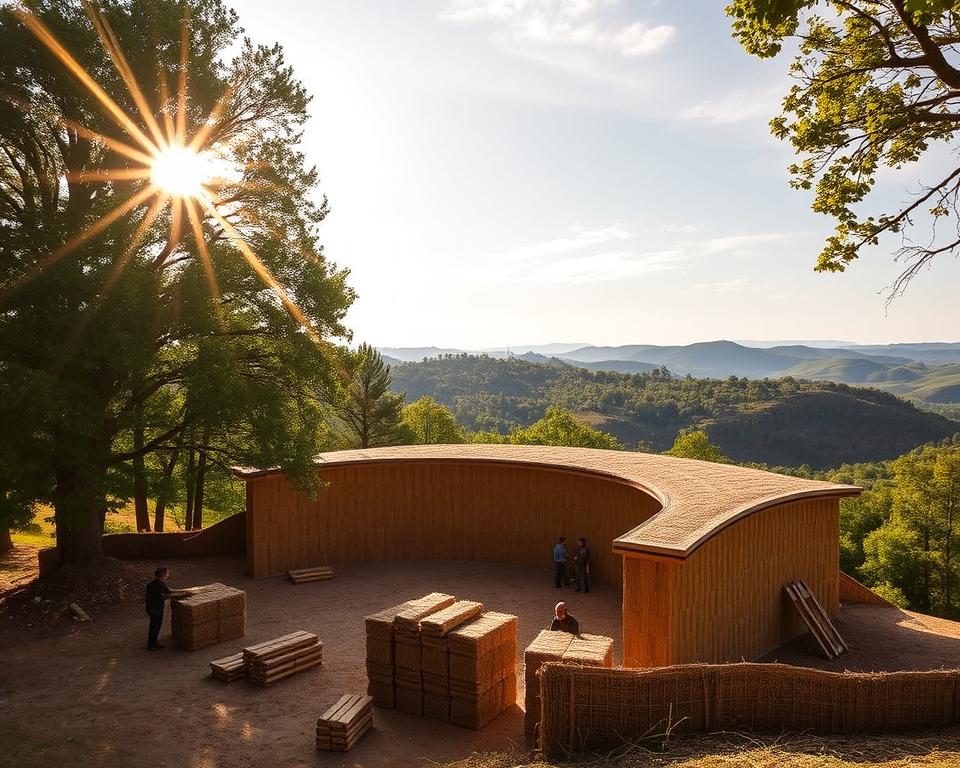
Timber Frame Construction Laurel: Balconies, Mezzanines, and Load Paths
Earth Bound Building: Straw bale Construction in Laurel
Did you know that houses built with eco-friendly materials may lower energy costs by up to 50%? It’s one key reason why increasing numbers of homeowners choose sustainable architecture. Earth Bound Building, serving Laurel, is at the forefront of this movement, focused on forward-thinking and low-energy projects.
Using renewable materials like straw bales within timber frames, Earth Bound Building builds home addition builders Laurel which are both environmentally friendly and remarkably long-lasting. This approach combines time-honored craftsmanship with contemporary sustainable practices, so that every project satisfies the top standards of sustainability.
Earth Bound Building’s differentiator is their craftsman-led approach and strong community involvement. They work closely with homeowners to craft spaces that match their values and needs. For those seeking a more sustainable way to build, Earth Bound Building is your go-to partner in Laurel.
About Straw bale Building?
Straw, sometimes treated as waste, is revolutionizing green building. Building with straw bales uses stacking bales in timber frames to build walls that are simultaneously thermal and structural. The approach uses an agricultural byproduct, thereby being a renewable and low-impact choice.
Straw comes from grain crops such as wheat, rice, or barley. Rather than burning or discarding it, farmers can sell it for construction. That cuts agricultural waste and offers a sustainable material for homes. The method is straightforward, well-suited to owner-builders and community projects.
One of the notable features of straw bale walls is their insulation performance. Versus traditional materials like fiberglass or wood, straw bales have a higher R-value. That means they hold heat better, resulting in decreased energy costs. Below is a quick comparison:

| Material Type | R-Value (per inch) |
|---|---|
| Straw Bale | R-2.38 |
| Fiberglass | R-2.20 |
| Wood | R-1.41 |
Another advantage is the use of non-toxic materials. Straw bales are free from harmful chemicals, supporting healthier indoor air quality. Consequently, they are a wise choice for families and green-minded homeowners.
In summary, straw bale construction is a sustainable, high-efficiency, and health-friendly option. It’s a perfect fit for those aiming to reduce their environmental footprint while benefiting from long-term savings.
Why Partner with Earth Bound Building for Your Project?
Picking the right team for your eco-friendly project can make all the difference. Earth Bound Building is a leader in eco-friendly design, offering advanced solutions customized for your needs. Our approach combines state-of-the-art techniques with a profound respect for the environment.
Commitment to Sustainability
Earth Bound Building emphasizes sustainable practices in every project. They use carbon-storing straw and reduced-impact materials to lower environmental impact. In addition to ecological gains but also contributes to long-term savings for homeowners.
Their partnerships with regional farmers guarantee ethically sourced materials. By backing local agriculture, they reinforce a circular economy. This commitment to sustainability sets them apart in the industry.
Local Expertise in Laurel
With strong connections in Laurel, Earth Bound Building knows the unique needs of the area. They are well-versed in local climate conditions, permitting processes, and supply chains. This expertise supports smooth project execution and compliance with regulations.
Their tailored designs fit Laurel’s aesthetic preferences while meeting strict building codes. Whether it’s a residential or commercial project, they produce results that harmonize with the local environment.
| Focus | Earth Bound Building | Conventional Methods |
|---|---|---|
| Sourcing of Materials | Local, ethically sourced straw | Imported, high-embodied energy materials |
| Energy Efficiency | High R-value insulation | Standard insulation |
| Carbon Footprint | Low carbon footprint | Higher emissions |
Earth Bound Building’s focus to sustainability and local expertise makes them a natural fit for your next project. Their progressive practices and community-focused approach deliver a seamless and eco-friendly experience.
The Benefits of Straw-bale Building Laurel
Sustainable architecture is growing rapidly for its ability to merge innovation with environmental responsibility. One of the most compelling methods in this field is the use of straw bales. This approach offers a range of benefits, from energy efficiency to eco-friendliness, making it an appealing option for modern homeowners.
Energy Efficiency and Cost Savings
Straw bale walls deliver excellent insulation, beating traditional materials such as fiberglass. With an R-value of 2.38 per inch, they help stabilize indoor temperatures, cutting the need for heating and cooling. This can produce energy savings of up to 50-75%.
Over time, these savings help offset the initial construction costs. Homeowners gain lower energy bills while supporting a greener planet. Below is how straw bales measure up to other materials:
| Material Type | R-Value (per inch) |
|---|---|
| Straw Bale | R-2.38 |
| Fiberglass | R-2.20 |
| Wood | R-1.41 |
Eco-Friendly and Renewable
Straw is a regenerative resource that regrows annually, in contrast to timber, which takes decades to mature. Using straw in construction reduces agricultural waste and promotes a circular economy. It also locks in CO₂ in the walls, contributing to fighting climate change.
Additionally, straw bale walls are free of toxic additives, supporting better indoor air quality. They are also fire-resistant, with plastered walls exceeding 2-hour fire ratings. This makes them a safe and eco-friendly choice for any project.
By choosing straw bale construction, you’re building more than a house—you’re committing to a more wholesome, more sustainable future.
How Straw-bale Homes Are Constructed
There are multiple ways to build sustainable homes using straw bales. Each method provides unique benefits, from structural support to streamlined installation. Understanding these approaches can help you decide on the best approach for your project.
Nebraska Style vs. In-Fill Wall Systems
The Nebraska Style is a historical method where straw-bale walls serve as the primary structural support. This approach is a great fit for smaller homes and emphasizes simplicity. The bales are stacked directly on the foundation, eliminating the need for additional posts or frames.
In contrast, In-Fill Wall Systems use timber frames to take the structural load. The bales are fitted within these frames, enabling faster roof installation and broader design flexibility. This method is preferred for larger projects where customization is key.
Prefabricated Straw Wall Panels
Prefabricated panels are a next-gen innovation in straw bale construction. These factory-built panel sections cut on-site work and lower weather-related risks. They are designed for quick assembly, making them a practical choice for time-sensitive projects.
Below is a comparison of the three methods:
| Approach | Key Features | Best For |
|---|---|---|
| Nebraska Style | Load-bearing bales, simple process | Small homes |
| In-Fill Systems | Timber frames, design flexibility | Larger projects |
| Prefabricated Panels | Factory-built, reduced assembly time | Quick installations |
Each method has its strengths, and the choice is guided by your project’s needs. Whether you prefer traditional techniques or modern innovations, straw bale construction delivers a responsible and time-savvy solution.
Common Myths About Straw-bale Construction
Many people hold myths around sustainable materials like straw. These myths frequently prevent homeowners from exploring eco-friendly options. Let’s clear up some of the most common concerns.
Fire Resistance and Safety
One of the biggest myths is that straw is a fire hazard. In reality, compressed bales do not have the oxygen needed to burn. Lab tests demonstrate that plastered straw walls can withstand 2+ hours of fire exposure. This exceeds the fire resistance of many traditional materials like wood.
Plaster acts as a protective barrier, encasing the bales and stopping ignition. This keeps straw-based structures safer than many people assume. Below is a quick comparison:
| Material | Fire Resistance |
|---|---|
| Straw (plastered) | 2+ hours |
| Wood | 1 hour |
Pest and Moisture Management
Another concern is pests. Straw has little to no nutritional value, making it unattractive to rodents and insects. When finished with plaster, it becomes very hard for pests to penetrate. This eliminates one of the most common worries homeowners worry about.
Moisture is also controllable with proper design. Elevated foundations, wide eaves, and permeable finishes like vapor-permeable stucco reduce the risk of rot. Modern techniques ensure these homes remain durable for decades.
Here’s how straw compares to traditional materials in moisture control:
| Assembly | Moisture Resistance |
|---|---|
| Straw with Proper Design | High |
| Wood without Treatment | Low |
By addressing these myths, it’s clear that straw-based structures are a sound, sustainable, and enduring choice for modern homes.
Is a Strawbale Home Right for You?
Designing a home that’s both appealing and green is easier than you think. With unique features like thick window niches and curved designs, eco-friendly homes deliver endless possibilities. Consider why this could be the perfect choice for you.
Customization and Aesthetic Appeal
One of the defining features of these homes is their design flexibility. You can create artful walls, arched doorways, and built-in shelving to match your style. The thick walls also provide excellent acoustic privacy, reducing outside noise significantly.
Rustic plaster finishes lend a unique charm, combining modern aesthetics with natural elements. Whether you’re an artist or an eco-conscious family, these homes can be customized to mirror your personality and needs.
Long-Term Benefits and Sustainability
Opting for a sustainable home isn’t just about the environment—it’s also a wise financial decision. These homes cost less to maintain over time, thanks to their energy efficiency. With reduced heating and cooling bills, you’ll see significant savings on utilities.
Additionally, green homes often qualify for tax incentives and have higher property values. Here’s a quick comparison of lifecycle costs:
| Cost Area | Straw Bale Homes | Conventional Homes |
|---|---|---|
| Energy Costs | Lower | Higher |
| Upkeep | Minimal | Regular |
| Property Value | Higher | Standard |
Earth Bound Building’s planning process makes sure your goals match your budget. Whether you’re looking for an off-grid retreat or a family home, they’ll support you every step of the way.
The Bottom Line
Adopting eco-friendly living is powered by the right materials and the right team. Straw bale homes offer unmatched benefits, from energy efficiency to resilience. They cut costs while supporting the environment, making them a forward-thinking choice for modern homeowners.
Earth Bound Building leads the way in sustainable building in Laurel. Their expertise ensures every project achieves the top standards of quality and environmental responsibility. Join the growing community of homeowners who’ve chosen this modern approach.
Ready to take the next step? Speak with Earth Bound Building for a personalized consultation. Attend their workshops or visit completed projects to see the benefits firsthand. Building with bale not only creates a house but also bolsters regenerative agriculture and local economies.